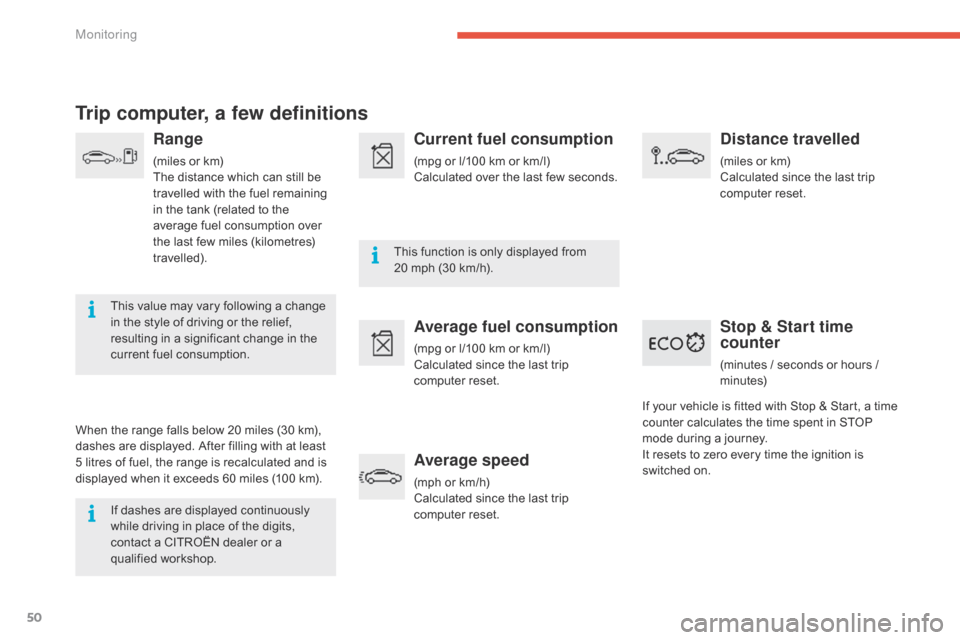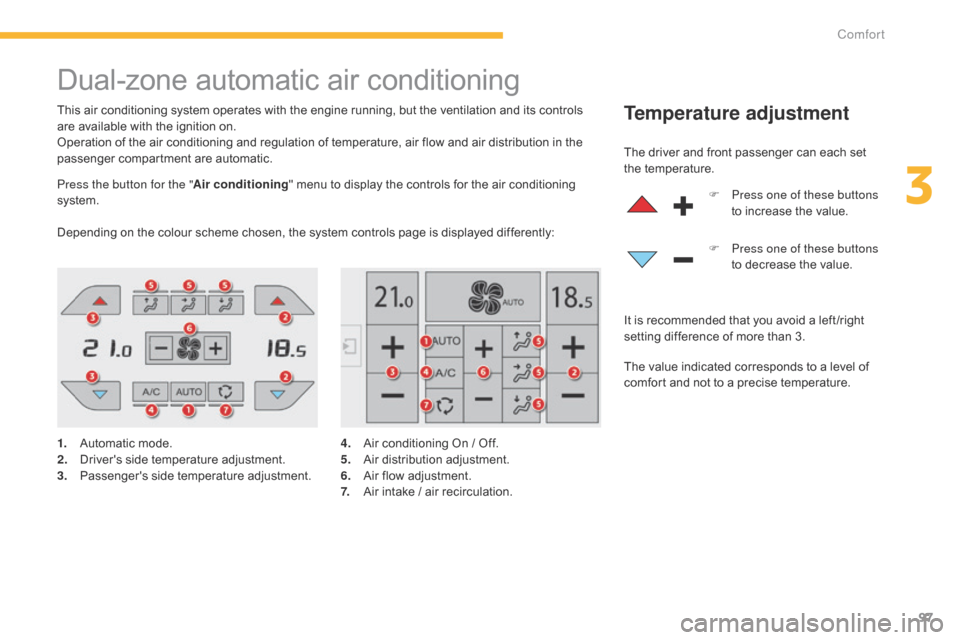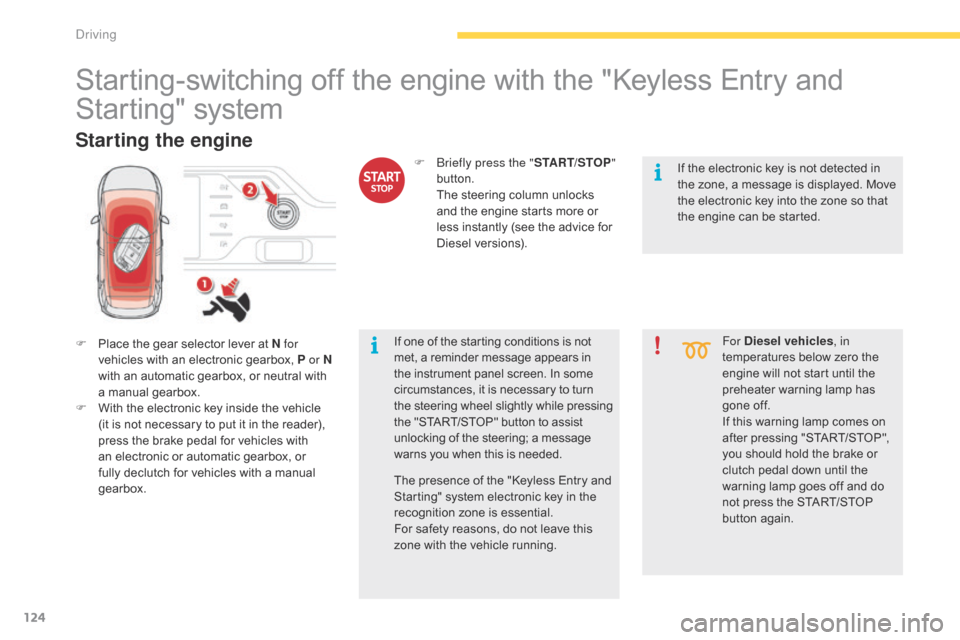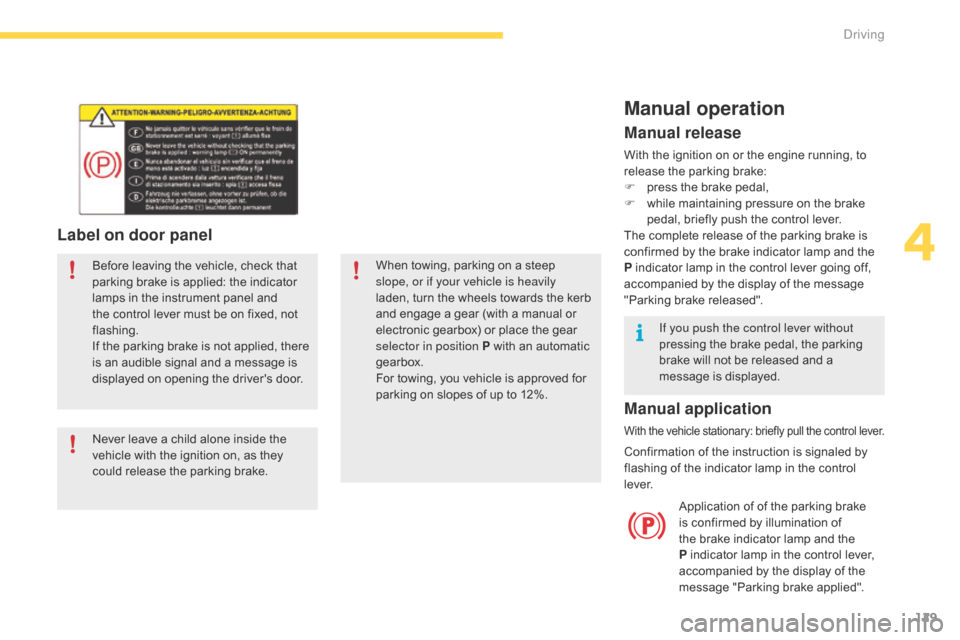display Citroen C4 PICASSO 2015 2.G Owner's Guide
[x] Cancel search | Manufacturer: CITROEN, Model Year: 2015, Model line: C4 PICASSO, Model: Citroen C4 PICASSO 2015 2.GPages: 420, PDF Size: 10.72 MB
Page 52 of 420

50
Trip computer, a few definitions
Range
(miles or km)
T he distance which can still be
t
ravelled with the fuel remaining
i
n the tank (related to the
a
verage fuel consumption over
t
he last few miles (kilometres)
t
ravelled).
This
value may vary following a change
i
n
the
style of driving or the relief,
r
esulting in a significant change in the
c
urrent
fuel consumption.
When
the
range falls below 20 miles (30 km),
d
ashes
are
displayed. After filling with at least
5
litres
of
fuel,
the range is recalculated and is
d
isplayed
when it exceeds 60 miles (100 km).
If
dashes are displayed continuously
w
hile
driving in place of the digits,
c
ontact
a CITROËN dealer or a
q
ualified
w
orkshop. This
function is only displayed from
2
0 mph (30 km/h).
Current fuel consumption
(mpg or l/100 km or km/l)
C alculated over the last few seconds.
Average fuel consumption
(mpg or l/100 km or km/l)
C alculated since the last trip
c
omputer
re
set.
Average speed
(mph or km/h)
C alculated since the last trip
c
omputer
re
set.
Distance travelled
(miles or km)
C alculated since the last trip
c
omputer
re
set.
Stop & Start time
counter
(minutes / seconds or hours / minutes)
If
your
vehicle
is fitted with Stop & Start, a time
c
ounter
calculates the time spent in STOP
m
ode
during
a journey.
It
resets
to
zero every time the ignition is
s
witched
on.
Monitoring
Page 61 of 420

59
Remote control problem -
reinitialisationChanging the battery
Following disconnection of the vehicle battery, r
eplacement of the remote control battery or
i
n the event of a remote control malfunction,
y
ou can no longer unlock, lock or locate
y
our vehicle.
F
P
lace the mechanical key (integral with
t
he remote control) in the lock to unlock
y
our vehicle.
F
P
lace the electronic key in the reader.
F
S
witch on the ignition by pressing START/
S T O P.
The
electronic key is fully operational again.
If
the problem persists, contact a CITROËN
d
ealer or a qualified workshop as soon as
p
ossible. Do
not throw the remote control
b
atteries away, they contain metals
w
hich are harmful to the environment.
Take
them to an approved collection
po
int.
Battery
ref.: CR2032 / 3 volts.
Battery replacement is signalled by the display
o
f a message.
F
U
nclip the cover using a small screwdriver
a
t the cutout.
F
L
ift off the cover.
F
R
emove the flat battery from its location.
F
F
it the new battery into its location
observing
the original direction of fitment.
F
C
lip the cover onto the casing.
2
Access
Page 96 of 420

94
Heating
Temperature adjustment
F Press one of these buttons, or move the cursor from blue
(
cold) to red (hot) to adjust the
t
emperature to your wishes.
Air flow adjustment
F Press one of these buttons to increase or decrease the speed
o
f the booster fan.
Air distribution adjustmentThe intake of exterior air prevents and eliminates misting of the windscreen and side
w
indows.
The
recirculation of interior air prevents exterior
o
dours and smoke entering the passenger
c
ompartment.
Windscreen.
Centre
and
side
vents.
Footwells. The
air distribution can be varied by using more
t
han one button.
Each press of a button activates or deactivates
t
he function.
The indicator lamp is on when the button is
a
ctivated. For an even distribution of air in the
p
assenger compartment, the three buttons can
b
e activated simultaneously.
Air intake / Air recirculation
F Press this button to recirculate
the interior air. The indicator
l
amp in the button comes on.
F
P
ress the button again to allow
t
he intake of exterior air. This is
c
onfirmed by the indicator lamp
g
oing off.
Avoid
driving
for
too
long
without
v
entilation
(risk
of
misting
and
d
eterioration
of
air
quality).
The
heating
system
works
only
when
the
e
ngine
is
running.
Press the button for the " Air conditioning"
menu
to
display
the
page
for
the
system
c
ontrols.
The
symbol
for
air flow
(a
fan)
fills
progressively
a
ccording
to
the
air
flow
setting
made.
By
reducing
the
air
flow
to
the
minimum,
you
a
re
stopping
ventilation
of
the
passenger
c
ompartment.
Comfort
Page 97 of 420

95
Dual-zone manual air conditioning with temperature regulation
The air conditioning system operates with the engine r unning.
The
temperature at the nozzles and vents
i
s regulated by the system according to the
t
emperature in the passenger compartment
a
nd the temperature setting.
Press the button for the " Air conditioning"
menu
to display the system controls page.Temperature adjustment
F Press one of these buttons to reduce (blue) or increase (red)
t
he value.
Air flow adjustment
Press one of these buttons to
increase or decrease the speed of
t
he air booster fan.
The
driver
and
front
passenger
can
each
adjust
t
he t
emperature.
The value indicated corresponds to a level of c
omfort and not to a temperature in degrees Celsius o
r Fahrenheit (depending on the unit selected).
A setting of around 21 provides optimum comfort. Depending on your requirements, a
s
etting between 18 and 24 is normal.
In
addition, it is recommended that a difference
b
etween left and right of more than 3 should be
av
oided. The
air flow symbol (a fan) fills progressively
a
ccording to the quantity of air wanted.
By reducing the air flow to minimum, you are
s
topping
v
entilation.
Avoid
d
riving
t
oo
l
ong
w
ithout
v
entilation
(
risk of misting and deterioration of air
q
uality).
3
Comfort
Page 99 of 420

97
Dual-zone automatic air conditioning
This air conditioning system operates with the engine running, but the ventilation and its controls are available with the ignition on.
Operation
of the air conditioning and regulation of temperature, air flow and air distribution in the
p
assenger compartment are automatic.Temperature adjustment
1. Automatic mode.
2. D river's side temperature adjustment.
3.
P
assenger's
s
ide
t
emperature
a
djustment. The
driver and front passenger can each set
t
he
t
emperature.
F
P
ress one of these buttons
to increase the value.
The value indicated corresponds to a level of
c
omfort and not to a precise temperature.
It is recommended that you avoid a left /right
s
etting difference of more than 3.
Depending on the colour scheme chosen, the system controls page is displayed differently:
4. A ir conditioning On / Off.
5. A ir d istribution a djustment.
6.
A
ir flow adjustment.
7.
A
ir intake / air recirculation.
Press the button for the "
Air conditioning" menu to display the controls for the air conditioning
s
ystem.
F
P
ress one of these buttons
to decrease the value.
3
Comfort
Page 100 of 420

98
In cold weather with the engine cold, the air flow is increased gradually until
t
he system has warmed up, in order
t
o limit the delivery of cold air into the
p
assenger
c
ompartment.
On
entering the vehicle, if the interior
t
emperature is much colder or warmer
t
han the comfort value setting, there
i
s no need to alter the value displayed
i
n order to reach more quickly the
r
equired level of comfort. The system
c
ompensates automatically and
c
orrects the temperature difference as
q
uickly as possible.
This
setting is associated with AUTO mode
o
nly.
However, on deactivation of AUTO mode,
t
he
indicator for the last setting remains on.
Changing the setting does not reactivate AUTO
m
ode
if deactivated.
When
the
indicator
lamp
in
the
button
is
on,
the
a
ir
conditioning
system
operates
automatically:
t
he
system
manages
the
temperature,
air
f
low
and
air
distribution
in
the
passenger
c
ompartment
in
an
optimum
way
according
to
t
he
comfort
level
you
have
selected.
F
P
ress the "AUTO"
button
to
activate
or
deactivate
the
a
utomatic
mode
of
the
air
c
onditioning
system.
Automatic comfort
programme
To change the current setting, shown by the g
reen indicator lamp, press the button for the
de
sired
m
ode:"Soft":
provides soft and quiet
o
peration by limiting air flow.
"Normal":
o
ffers
t
he
b
est
c
ompromise
b
etween a comfortable temperature
a
nd quiet operation (default setting).
"Fast":
provides strong and effective
a
ir flow.
It
is
possible
to
modulate
the
intensity
of
the
a
utomatic
comfort
programme
by
choosing
one
o
f
three
mode
settings
offered
in
a
secondary
p
age
of
the
" Air conditioning "
menu.
Comfort
Page 101 of 420

99
You can modulate the distribution of air in the passenger compartment using these three buttons.
Air flow adjustment
Avoid driving for too long with the ventilation off (risk of misting and
d
eterioration of air quality).
Air distribution adjustment
F Press one of these buttons to increase or decrease the speed
o
f the booster fan.
The
air
flow symbol (a fan) is filled in
p
rogressively in relation to the quantity of air
w
anted.
By
reducing the air flow to minimum, you are
s
topping
v
entilation.
" OFF "
is
displayed alongside the fan. Windscreen.
Footwells.
Centre
and side vents.
Each
press on a button activates or deactivates
t
he function. The indicator lamp is on when the
b
utton is activated. For a uniform distribution in
t
he passenger compartment, all three buttons
c
an be pressed simultaneously.
Manual control
You can manually adjust one or more settings, while retaining automatic control of the other
f
unctions:
-
a
ir flow,
-
a
ir distribution.
F
P
ress the "AUTO"
button again
t
o activate the automatic comfort
p
rogramme
ag
ain.
As
soon as you modify a setting, the indicator
l
amp in the "AUTO "
button goes off.
In
AUTO mode, the indicator lamps in all three
b
uttons are off.
3
Comfort
Page 112 of 420

110
Depending on equipment, one or two USB ports are located in the central storage box.
They
allow the connection of a portable device
o
r a USB memory stick.
They
read the audio files which are transmitted
t
o your audio equipment and played via the
v
ehicle's
s
peakers.
You
can manage these files using the steering
m
ounted or touch screen tablet controls.
USB ports
When a USB port is used, the portable device charges automatically.
A
message is displayed if the power
c
onsumption of the portable device
e
xceeds the current supplied by the
v
ehicle.
Only
the right hand USB port can be
u
sed to connect an Apple
® player or the
"CITRoËn M
ULTICITY Co nnE CT"
connection
k
ey.
Comfort
Page 126 of 420

124
Starting-switching off the engine with the "Keyless Entry and
S
tarting" system
F Place the gear selector lever at N for
vehicles with an electronic gearbox, P or N
with
an automatic gearbox, or neutral with
a m
anual
g
earbox.
F
W
ith the electronic key inside the vehicle
(
it is not necessary to put it in the reader),
p
ress the brake pedal for vehicles with
a
n electronic or automatic gearbox, or
f
ully declutch for vehicles with a manual
g
earbox. For Diesel vehicles
, in
temperatures below zero the
e
ngine will not start until the
p
reheater warning lamp has
g
one off.
If
this warning lamp comes on
a
fter pressing "START/STOP",
y
ou should hold the brake or
c
lutch pedal down until the
w
arning lamp goes off and do
n
ot press the START/STOP
bu
tton
ag
ain.
Starting the engine
If one of the starting conditions is not met, a reminder message appears in t
he instrument panel screen. In some
c
ircumstances, it is necessary to turn
t
he steering wheel slightly while pressing
t
he "START/STOP" button to assist
u
nlocking of the steering; a message
w
arns you when this is needed.
F
b
r
iefly press the "
START/STOP"
button.
T
he steering column unlocks
a
nd the engine starts more or
l
ess instantly (see the advice for
D
iesel
v
ersions).
The presence of the "Keyless Entry and
S
tarting" system electronic key in the
r
ecognition zone is essential.
For
safety reasons, do not leave this
z
one with the vehicle running. If
the electronic key is not detected in
t
he zone, a message is displayed. Move
t
he electronic key into the zone so that
t
he engine can be started.
Driving
Page 131 of 420

129
Label on door panel
Before leaving the vehicle, check that parking brake is applied: the indicator
l
amps in the instrument panel and
t
he control lever must be on fixed, not
f
lashing.
If
the parking brake is not applied, there
i
s an audible signal and a message is
d
isplayed on opening the driver's door.
Never
leave a child alone inside the
v
ehicle with the ignition on, as they
c
ould release the parking brake.When
towing, parking on a steep s
lope, or if your vehicle is heavily
laden,
turn the wheels towards the kerb
a
nd engage a gear (with a manual or
e
lectronic gearbox) or place the gear
s
elector in position P with an automatic
g
earbox.
For
towing, you vehicle is approved for
p
arking on slopes of up to 12%.
Manual operation
Application of of the parking brake is confirmed by illumination of
t
he brake indicator lamp and the
P
indicator lamp in the control lever,
a
ccompanied by the display of the
m
essage "Parking brake applied".
Manual release
With the ignition on or the engine running, to release the parking brake:
F
p
ress the brake pedal,
F
w
hile maintaining pressure on the brake
p
edal, briefly push the control lever.
The
complete release of the parking brake is
c
onfirmed by the brake indicator lamp and the
P
indicator lamp in the control lever going off,
a
ccompanied by the display of the message
"
Parking brake released".
If you push the control lever without
pressing
the brake pedal, the parking
b
rake will not be released and a
m
essage is displayed.
Manual application
With the vehicle stationary: briefly pull the control lever.
Confirmation of the instruction is signaled by f
lashing of the indicator lamp in the control
l
eve r.
4
Driving